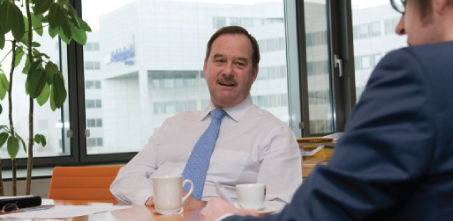
Rutten stressed that capacity is a high priority in terms of both runways and terminal infrastructure. ACI EUROPE has long warned that Europe is facing an airport capacity crunch, with air traffic forecast to double by 2030. “This is an issue that requires a lot of investment,” said Rutten.
Amsterdam Airport Schiphol’s success in 2010 is indicative of the return to growth of Europe’s aviation sector. The airport saw passenger numbers increase by +3.8% to 45.3 million passengers, while cargo volumes grew by +16% to 1.5 million tonnes. Those figures would actually have been even higher were it not for the impact of external shocks, such as last April’s volcanic ash cloud. The positive trend is set to continue this year. “We forecast growth of 4% to 7% in 2011, in terms of both passengers and cargo. This will be driven by airline optimisation and also the launch of new services by the airlines,” said Rutten. “For the first time since the crisis began, we will also see an increase in aircraft movements again, of 4%.”
Recently released figures for January 2011 are promising and suggest this confidence is well-founded. Amsterdam Airport Schiphol’s dynamic growth has continued; while overall passenger traffic at Europe’s airports rose by +7.5% in January, Schiphol saw growth of +10.8% to 3.26 million. Similarly, while overall freight traffic across Europe increased by +10.3% in January, Schiphol enjoyed impressive growth of +14.3% to 122,254 tonnes.
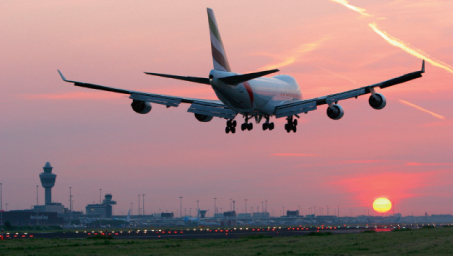
Rutten explained that Schiphol sees the benefits of A-CDM and will be implementing it for all flights in regular service by the end of the year.
Enhancing the passenger experience
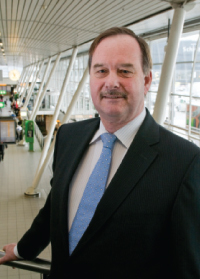
The upgrade to Schiphol’s baggage handling system will be complete at the end of 2012. Rutten explained that there has been a change of philosophy from a ‘push’ to a ‘pull’ concept. “If the transfer time is longer than an hour, baggage can be directed to the bag store. It is a different system from existing ones and a big advantage for us. At peak times, there will be lower pressure on the baggage handling system.”
Schiphol retains its one-terminal concept to ensure it remains passenger-friendly and easy to navigate. Its use of innovation to enhance the passenger experience saw the launch of the Innovative Gate in June 2010. The gate, located at Pier G, was entirely redesigned and refitted, with an emphasis on the revolutionary use of elements such as lighting, design and dynamic information services to create a pleasant gate experience. Cathay Pacific was the first carrier to use the gate, which has full airline branding capabilities; in December 2010, it was announced that Singapore Airlines, United Airlines and ArkeFly – a Dutch charter carrier – would also start using the ultra-modern gate.
“We worked with Philips on the launch of Innovative Gate. Philips added new lighting, which can be changed depending on the brand colours of the airline using the gate. Lighting can also be used to change the ambience at the gate; for example, the lighting can be turned up when the aircraft is ready for boarding to encourage action,” commented Rutten. “Passenger satisfaction is up and the feedback has been positive. We will take learning from this project and apply it to our future expansion.”
Another key area of innovation is the upgrade of the airport’s baggage handling system, which is currently in the last phase of development and scheduled to be completed at the end of 2012. The €800 million initiative – currently the airport’s largest investment programme – is known as ’70MB’ – a reference to the capacity of 70 million bags per year that it will provide. The new baggage system will allow Schiphol to maintain and improve its hub operation, optimising the flow of transfer baggage, and as such the project is being developed in collaboration with KLM.
Rutten explained that there will be a high level of automation. “We are working within a minimum transfer window of 40 minutes for intra-EU traffic and 50 minutes for intercontinental traffic. The hourly rate will go up to 9,000 transfer bags per hour,” he said.
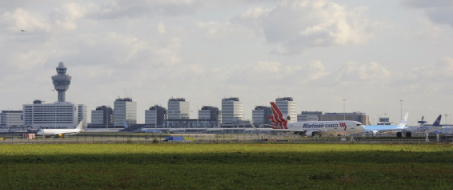
The airport saw passenger numbers increase by +3.8% to 45.3 million in 2010, while cargo volumes grew by +16% to 1.5 million tonnes. Those figures would actually have been even higher were it not for the impact of external shocks, such as last April’s volcanic ash cloud. Growth of 4% to 7% is forecast in 2011, in terms of both passengers and cargo.
In 2005, Schiphol became the first European airport to test a baggage robot designed to load containers and trolleys. An improved version was installed in 2008, with six robots set to be up and running in the new South baggage hall, which will become operational in October 2011. These six robots will together load 60% of all baggage items. According to Rutten, the mechanical unloading system constitutes another crucial innovation. The system picks up the containers, tips and empties them. “From the point of starting the unloading process with a ramp snake, in theory a bag can transfer at Schiphol without anyone handling it manually. This means human hands will only be needed to operate the control panel. Baggage handling staff will be controlling the process rather than doing any heavy lifting,” he said.
The project will include expansion of three existing baggage halls D, E and South, and the construction of a high-speed mechanical conveyor system that will increase transfer baggage capacity by 50% from 6,000 to 9,000 per hour. The baggage storage facility will be increased from 4,000 to 8,700 bags. “The philosophy has changed from a ‘push’ to a ‘pull’ concept. If the transfer time is longer than an hour, baggage can be directed to the bag store. It is a different system from existing ones and a big advantage for us. At peak times, there will be lower pressure on the baggage handling system,” explained Rutten.
Testing ground for innovation
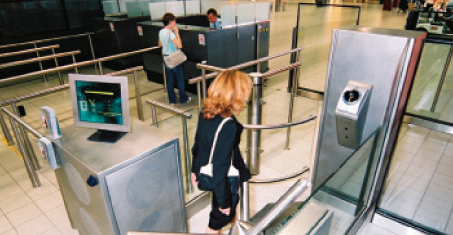
Schiphol’s frequent flyer customer loyalty scheme – Privium – has been in place since 2001. The key feature is fast, secure automated border passage, utilising iris recognition.
Schiphol is leading the way in terms of developing innovative applications to enhance airport sustainability. In 2010 it launched theGROUNDS, which is described as a knowledge cluster in which companies, government agencies and academic institutions will collaborate on tailor-made applications for Schiphol. The first organisations to join theGROUNDS are Delft University of Technology, the Netherlands Organisation for Applied Scientific Research (TNO), Wageningen University & Research Centre, and Imtech – a company specialising in ‘green’ technologies.
“We are in the final stage of the contract with our partners. theGROUNDS is located on an area of land adjacent to the airport where we can offer small start-up companies and students opportunities to work on sustainable projects,” explained Rutten.
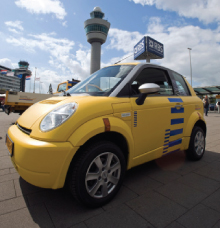
Schiphol has expressed the ambition to become carbon neutral in its own operations by 2012 and generate 20% of all its energy requirements sustainably by 2020. The airport has purchased 20 electric vehicles and is urging its subcontractors to similarly use environmentally friendly vehicles.
Schiphol is seeking to develop further its successful microalgae pilot project in theGROUNDS. Microalgae produce oxygen, which degrades the glycol substance used to de-ice aircraft. The waste released from biodegradation will serve as food for the microalgae and the residual heat released from the buildings will provide the necessary heating for the microalgae. The purified water will ultimately be recycled and used in the airport’s operational processes. Combining the components of waste, water and heating in the airport’s processes will enable Schiphol to achieve sustainable water purification. “Our ambition is a full working algae plant by winter 2011/12. The algae produced is high quality,” said Rutten.
Schiphol has expressed the ambition to become carbon neutral in its own operations by 2012 and generate 20% of all its energy requirements sustainably by 2020. The airport is also striving to improve water quality. It is hoped that the innovative applications yielded by theGROUNDS will allow Schiphol to achieve these objectives ahead of schedule.
The airport has also purchased 20 electric vehicles, which will be delivered from mid-2011 to 2013 and is urging its subcontractors to similarly use environmentally friendly vehicles – the airport buses are compliant with Euro 5 emissions standards and the taxis are eco-friendly, for example.
ACI EUROPE and EUROCONTROL introduced the Airport Collaborative Decision Making (A-CDM) Action Plan in 2008 and last year CANSO entered the partnership. The central idea is to improve the operational efficiency of all airport partners by reducing delays, streamlining the predictability of events during the progress of a flight and optimising the utilisation of resources. Schiphol is one of 10 European airports committed to implementing Airport Collaborative Decision Making by the end of 2011.
“We are developing A-CDM at Schiphol in cooperation with KLM and air traffic control. We see the benefits in the process – by the end of the year, we will be implementing A-CDM for all flights in regular service. It will result in shorter taxi times and waiting times for aircraft. We will calculate fuel savings and measure the reduction in delays. It will enable the optimal use of airline fleets,” explained Rutten.
As we were just going to press, we also received word of Amsterdam Airport Schiphol becoming Airport Carbon Accredited at the ‘Optimisation’ level of the programme – the highest level possible without carbon offsetting.
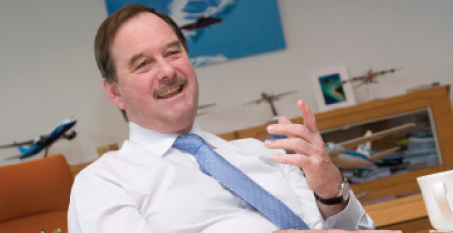
Rutten: “We forecast growth of 4% to 7% in 2011, in terms of both passengers and cargo. This will be driven by airline optimisation and also the launch of new services by the airlines. For the first time since the crisis began, we will also see an increase in aircraft movements again, of 4%.”
LAGs deadline
ACI EUROPE has identified four key challenges facing airports: Capacity, Environment, Connectivity and Security. The imminent 29 April deadline for the first phase lifting of Liquids, Aerosols & Gels (LAGs) restrictions is potentially disastrous, according to Rutten. “I am against implementing the rules on LAGs at this time, as there are currently no Type D machines that can help us with this. The aim is that passengers will be able to keep LAGs in their hand baggage, but technical trials with Type C machines in a testing environment generally produced a 20-30% false alarm rate, which is unacceptable with the volume of passengers using Europe’s hub airports every day. That level of misreadings would be a disaster,” he said.
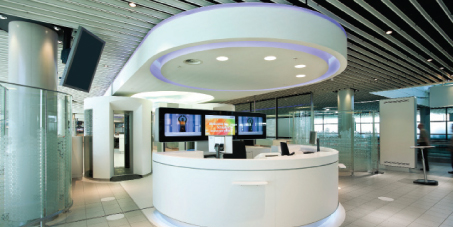
The Innovative Gate, located at Pier G, was entirely redesigned and refitted, with an emphasis on the revolutionary use of elements such as lighting, design and dynamic information services to create a pleasant gate experience.
Furthermore, there are currently only three countries – Croatia, Singapore and Malaysia – with so-called ‘third country recognition’. “I can envisage lines of 200-300 people waiting to have their liquids tested – it will be a disaster. What the European Commission expects to be of benefit to passengers, I think will be a disaster. It will be detrimental to the passenger experience,” added Rutten.
Schiphol’s frequent flyer customer loyalty scheme – Privium – has been in place since 2001. The key feature is fast, secure automated border passage, utilising iris recognition. The Privium programme currently has close to 50,000 members. It was taken to the next level in 2009, with the launch of the transatlantic ‘FLUX’ programme. Fast Low Risk Universal Crossing (FLUX) offers travellers between the US and the Netherlands the option of fast-track border crossing in the US for Dutch citizens and in the Netherlands for US citizens. Schiphol allows US travellers to use its Privium gates, while Privium members are entitled to use Global Entry programme border crossing facilities in the US. Rutten heralded the success of the FLUX programme and confirmed that Canada would be joining the alliance on 14 April as the next stage of the initiative through the Canpass Air programme which offers fast border passage at eight Canadian airports.
Recognising vital role of airports
Rutten stressed that capacity is a high priority in terms of both runways and terminal infrastructure. ACI EUROPE has long warned that Europe is facing an airport capacity crunch, with air traffic forecast to double by 2030. “This is an issue that requires a lot of investment,” said Rutten. “Fleet renewals by the airlines are bringing bigger aircraft, which means we are seeing capacity constraints without there being more flights – there are more passengers with the same amount of aircraft.” Indeed, Schiphol has found that the increasing number of larger aircraft it is receiving has meant having to remove some stands, effectively meaning it is losing capacity.
Ensuring competitiveness is another issue highlighted by Rutten, who emphasised the need for airports to develop their non-aeronautical revenue streams, which can help to fund the required investment in new infrastructure. “Every airport handling more than five million passengers per year must be regulated. Airports that play a vital role should have more leeway – there should be more support for small airports. The Observatory on Airport Capacity in the Single European Sky should be beneficial as a focal point for driving discussions. We, at ACI EUROPE, had pressed for such an Observatory,” he said.
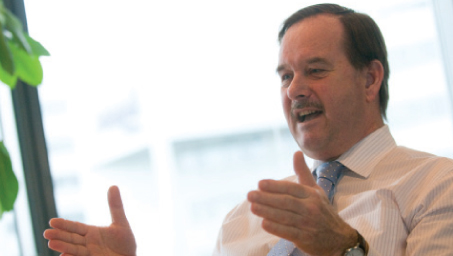
Rutten explained that since the opening of the Innovative Gate, “passenger satisfaction is up and the feedback has been positive”.
The White Paper on the Future of Transport is currently under development and Rutten stated unequivocally that it should be recognised that airports are vital to regional, national and indeed the EU economy. “Airports play a vital role for local economies, which thrive when air services come in. The captains of industry would not be in Amsterdam without Schiphol being here. It should also be recognised that airports are businesses in their own right, with the responsibility to fund expansion. In the bureaucracy of Europe, many people think that airports still live on public money,” he contended.
Amsterdam Airport Schiphol plans to increase its airport charges by an average of 0.6% from 1 April 2011. In 2009, Schiphol actually lowered its charges, while in 2010 they remained unchanged. This incorporates a charge related to the investment in the new baggage system; for the first time, Schiphol is charging the costs of the partial completion of the system. As a means of optimising its capacity utilisation, Schiphol is also considering introducing an incentive programme designed to encourage airlines to use the airport during off-peak hours and also to add new destinations to their networks.
Schiphol’s forward-thinking approach to innovation and sustainability are strengthening its position as a key hub airport. Already crucial to both the regional and national economies, Schiphol is a gateway for international trade and an engine for economic activity, and innovative initiatives such as theGROUNDS appear set to ensure further sustainable growth.







